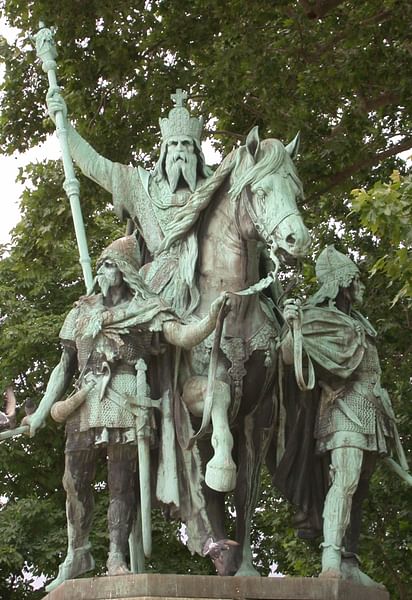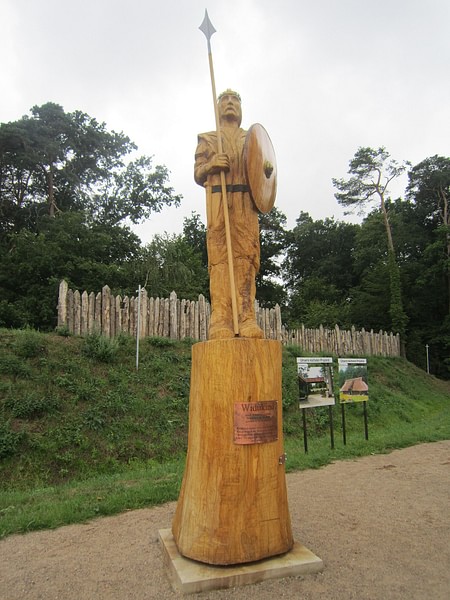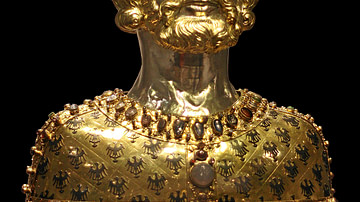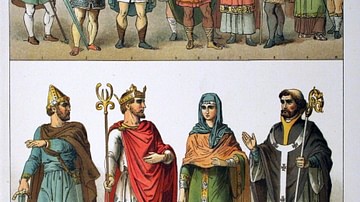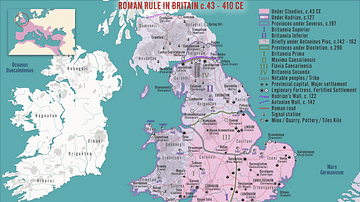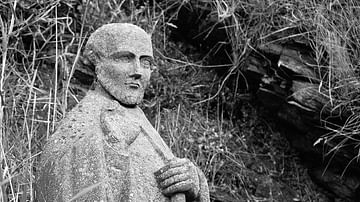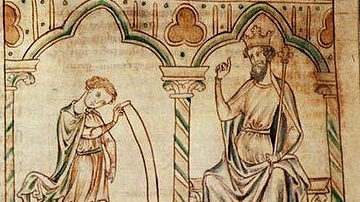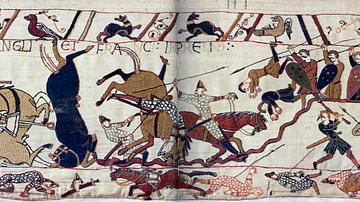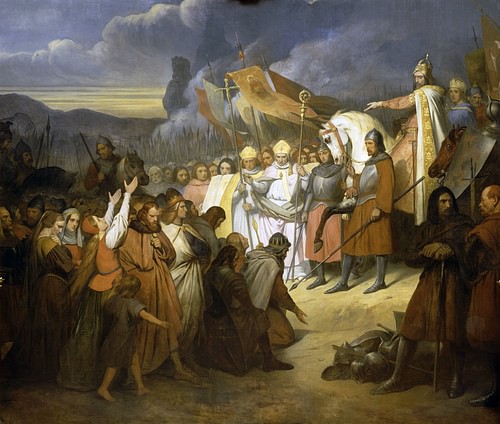
The Saxon Wars (772-804) were a series of conflicts between the Franks under Charlemagne, who sought to conquer Saxony and convert the populace to Christianity, and the Saxons who resisted. The conflict lasted over 30 years through 18 campaigns and cost thousands of lives before Charlemagne's victory in 804 and Saxon conversion/assimilation into the general population.
The immediate cause of the wars was the destruction of a church at Deventer in the modern-day Netherlands by the Saxons who objected to missionary work in their territories. Deventer had been founded c. 768 expressly for this purpose by the Anglo-Saxon missionary Lebuinus (d. 775) for the conversion of the people of Utrecht and the surrounding lands who, objecting to these efforts, allied themselves with the Saxons in order to preserve their traditional religious beliefs and customs.
The Frankish leaders Charles Martel (r. 737-741) and Pepin the Short (Mayor of the Palace of Neustria 741-751 and King of the Franks 751-768) had both tried unsuccessfully to subdue Saxony and so the cause was taken up by Charlemagne (King of the Franks 768-814, King of the Franks and Lombards 774-814, Holy Roman Emperor 800-814) who turned it into a crusade to Christianize Saxony by force. The wars were concluded by the deportation of 10,000 Saxons to Neustria in 804, who were then replaced in Saxony by Franks. The Saxons continued to exert a cultural influence in Saxony and elsewhere, but assimilation diluted the religious and cultural traditions they had fought for.
The Saxons
The Saxons were a Germanic people who settled in the region of Northern Germany at some point prior to the 4th century CE, eventually establishing their provinces of Angria, Eastphalia, and Westphalia in the region that came to be known as Saxony. Their first certain mention in the historical record comes from 356 when they are referenced as pirates raiding the coastal ports of Gaul and Britannia. They practiced a form of Germanic paganism, but the details of the observance are unknown as they kept no written record and had no standard text of scripture. Their social structure is also unclear for the same reason – they relied on oral tradition for the preservation of their culture – but it seems to have been informed by their religious beliefs.
Saxon society appears to have been a hierarchy with nobles at the top, then freemen, then lower class, then slaves. Sacrifices – sometimes including human sacrifice – were made to the gods and religious observances included veneration of a sacred pillar known as the Irminsul, which is sometimes characterized by later writers as a tree and is thought to have perhaps carried the same symbolism as the World Tree Yggdrasil, the Tree of Life, best known from Norse mythology. Scholar H. R. Ellis Davidson notes:
The description of the Irminsul as universalis columna is paralleled by the image of the World Tree, Yggdrasil, one of the most powerful symbols in Norse Mythology, said to stand at the center of the worlds of gods and men. Among Scandinavians of the Viking Age a tree appears to be the main symbol of the central pivot of the universe, but the so-called 'high-seat pillars' of wood which formed the main support in the center of halls and sanctuaries might be viewed as a northern version of the Germanic pillars raised in holy places. In the literary sources, such pillars are associated with the god Thor. (23)
How the Irminsul was regarded by the Saxons is unknown, as are any rituals associated with it, but the object was clearly of great religious, cultural, political, and military significance and community councils seem to have been convened in its presence. The Saxons had no king and no court but convened assemblies, in which members of all three classes had a voice, in deciding legal, political, social, and military matters. The 'provinces' of Saxony were not under any centralized government but were, more or less, self-governing according to shared cultural values.
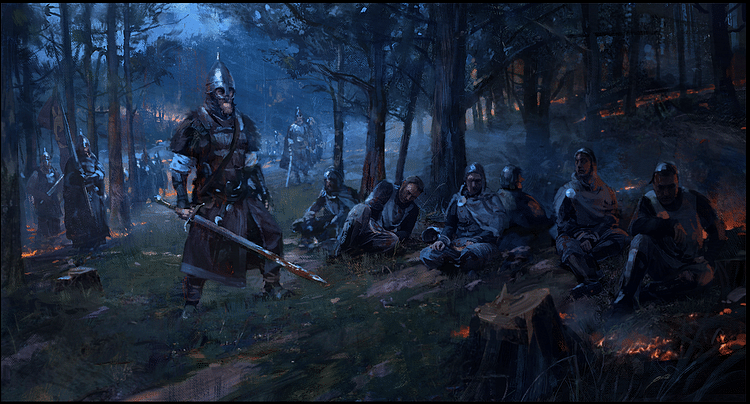
As their religious beliefs were intimately tied to their culture and society, they fiercely rejected the efforts of Christian missionaries to convert them. The later Carolingian Chronicles (Annals of the Kingdom of the Franks) notes how the Saxons interpreted conversion as the work of evil spirits bent on destroying them by turning faithful members of the community against long-held traditional customs and replacing them with new models. As they rejected Christianity, the Saxons resisted political and military pressure to force their submission to their neighbors the Franks who championed the cause of the new faith in unifying their kingdom.
Charlemagne
Charlemagne came to power as co-ruler with his younger brother Carloman I (r. 768-771) upon the death of their father Pepin the Short who had been granted the newly created title King of the Franks by the Church in 751. The Church controlled the reign of Pepin through a document known as the Donation of Constantine, which, it was claimed, had been drawn up after Constantine’s conversion to Christianity and established the Church as the sole political power on earth to which a Christian monarch willingly submitted, and the Church then granted authority to rule. The document was a forgery, but Pepin had no way of knowing this, and he pursued his policies in the interests of the medieval Church as much as for himself.
After his death, Charlemagne wanted to continue his policies, especially concerning military campaigns while Carloman I urged caution and diplomacy. Charlemagne ignored his brother and conducted successful campaigns in Aquitaine, angering Carloman I and threatening the prospect of civil war, when Carloman died in 771 and Charlemagne became the sole King of the Franks. He quickly defined himself as a champion of the Church – though there is no evidence he ever accepted the Donation of Constantine as an authoritative document – and proceeded against any who set themselves against church teachings through military campaigns.
Charlemagne's adviser, the clergyman and scholar Alcuin of York (l. 735-804), objected to this policy, noting that forced conversion had no value as one needed to come to Christ through one's own free will. Charlemagne rejected this council and his first effort at conversion by the sword was against the Saxons in 772 – even though it is unclear whether this was his major motivation at the beginning of the Saxon Wars. Scholar Roger Collins comments:
Individual campaigns by Charles Martel and Pepin had checked the Saxon pressure along the Lippe River, but had not turned Frankish rule into a reality in the area, let alone over Saxony more generally. In 772, Charlemagne was determined to subjugate the southern group of Saxons. This involved not just a military conquest, but also their integration into the Frankish cultural orbit through their forcible conversion to Christianity. Whether this was his intention from the start is not clear, but it had certainly become so by 775. (281)
The initial object of the first campaign of 772 was the taking of Eresburg and the destruction of the religious center there, which included the Irminsul and the sizeable treasury of its shrine.
Early Campaigns & Destruction of Irminsul
Charlemagne claimed justification for launching this campaign against the Saxons in retaliation for their destruction of the church at Deventer in 772. It seems clear, however – as Collins notes - that he was going to pursue military action against Saxony in keeping with the policies of Charles Martel, Pepin the Short, and the conversion efforts of the Church – even if Deventer church had never been touched.
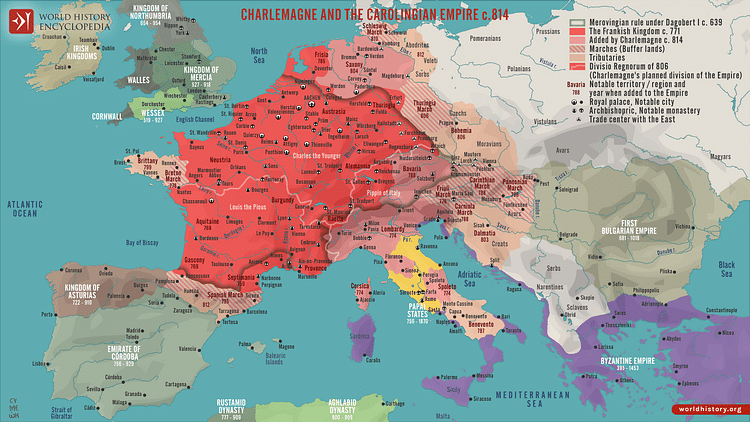
He struck at Eresburg, destroying the sacred Irminsul there, looting the shrine, and massacring the people before marching back to his own kingdom with several hostages to guarantee good behavior in adhering to the terms he had offered. Collins comments on the destruction of the Irminsul:
The exact nature of this object is uncertain, but its location in recently acquired territory on the expanding southern frontier of Saxon territory suggests that it was more than an item of traditional reverence and was directly associated with military victory and conquest. Thus its destruction was not only financially lucrative, because of the capture of the treasury of offerings in the shrine, but also intended as a blow to Saxon morale. (281)
Believing the Saxons would abide by his terms, he left the region alone and marched against the Lombards, conquering them in 774 and claiming the title King of the Franks and Lombards. The Saxons, possibly led at this time by Widukind (cited as the Saxon leader between 777-785), rejected Charlemagne's terms that same year, however, launching raids into Frankish territory, destroying Eresburg, and sacking a monastery in retaliation for the destruction of the Irminsul. Charlemagne turned his attention back to the region and defeated the Saxons in battle in 775, establishing fortifications and encampments to enforce his will before continuing military campaigns in the region of modern-day Italy.
Widukind, Verden Massacre & Saxon Laws
The Saxons again rose in 776 and were again put down by Charlemagne commanding his troops in person to punish those responsible for the rebellion. Widukind escaped and fled to Denmark where he negotiated an agreement with King Sigfried to allow Saxons to take refuge in his kingdom. This pact opened up an avenue from Saxony to Denmark, which many Saxons took advantage of to flee from Charlemagne's crusades. In 777, Charlemagne called an assembly at his newly established settlement of Paderborn to receive the submission of Saxon leaders and oversee their baptism.
Records of this event note Widukind was not among those present, and, although there is no solid evidence, it is probable he returned from Denmark to organize the further resistance which drew Charlemagne back to Saxony in 779. Collins comments on the difficulties Charlemagne faced in defeating the Saxons as opposed to his other adversaries, such as the Lombards:
In part, the problem in subduing the Saxons was the difficulty of the marshy terrain in and around the edges of which the fighting took place. This was a region that had baffled Roman efforts at conquest in the time of Augustus. But, perhaps more significantly still, was the nature of the Saxons' social and political organization. They had no kings or permanent central institutions. Nor, apart from such forts as Eresburg, did they have any large settlements. The basic Saxon social units were the extended families, and these occupied fortified farmsteads, rather like small villages…Thus, the Saxons could not be incapacitated by the defeat of a single leader, nor would the seizure or destruction of key settlements lead to a rapid conquest. (282)
In 782, Widukind again led the Saxons in revolt, destroying churches and massacring Frankish settlements. Charlemagne responded with another campaign and the infamous Massacre of Verden in which 4,500 Saxons were executed. He then issued the Ordinances Concerning Saxony (also known as the Saxon Capitularies) from Paderborn forbidding the practice of Germanic paganism on pain of death. The Ordinances, and other decrees, were drawn on for the issuance of the Lex Saxonum (Saxon Laws) in 802/803 toward the conclusion of the conflict, although these later laws were much more conciliatory than the earlier edicts.
In 785, Widukind presented himself before Charlemagne to swear fealty and receive Christian baptism. Afterward, Widukind disappears from the historical record, and Charlemagne seems to have regarded the Saxon Wars concluded and himself the victor. Although there are records of sporadic rebellions and civil unrest, there were no further large-scale uprisings for the next seven years.
Rebellion & Deportation
The Saxons rose again in 792, beginning in Westphalia, but this revolt was quickly suppressed. The peace did not last long, however, as another rebellion was launched in 796, which was once again addressed by Charlemagne in person at the head of his troops. As Collins notes, regarding Saxon surrenders and promises of fealty, "Such humiliating submissions were effective only as long as Charlemagne and the main Frankish army were present to enforce them" (282). Even so, and in spite of Charlemagne's personal command of his forces, the revolt continued (or sprang up again) through 798.
To stop the Saxons from receiving aid or escaping from his campaigns, Charlemagne ended the migration route to Denmark in 798 and increased pressure on the Saxons to submit and convert to Christianity. Perhaps in consideration of Alcuin's advice, Charlemagne softened his position on forced conversion and pagan observances and lifted the death penalty in 797 before issuing the Saxon Laws in 802/803. When resistance continued, he ordered 10,000 Saxons deported to Neustria and replaced them with Franks, ending the Saxon Wars.
Conclusion
Although Charlemagne seems to have rejected the Donation of Constantine, he clearly patterned his self-image on that of the first Roman emperor to have accepted and validated Christianity, even to the point of naming a city – Karlsburg – after himself just as Constantine had with Constantinople. Christian medieval texts defending Charlemagne reinforce this connection, claiming that Charlemagne, like Constantine, was a champion of the faith and the Saxons were "demons" who had set themselves up as the adversaries of Christ and so justly paid with their lives and autonomy.
Even the Christian sources, however, note the brutality of Charlemagne's campaigns against the Saxons claiming he "preached" to them "with an iron tongue." Scholar Philippe Contamine notes how "fear of a supernatural punishment and the desire to obtain God's protection or that of his saints sometimes led chieftains [of this period] to restrain or forbid devastation" (262). None of the accounts of the Saxon Wars suggests that Charlemagne adhered to this model in the least because, in his mind, he was a champion of the ultimate good battling the forces sent against him by dark, demonic forces.
The death toll of the Saxon Wars is unknown but, on the Saxon side, according to the Frankish annals, at least 10,000 were killed between 772-782, with a low estimate of at least 4,000 more by 800. The Saxons would continue to honor their traditions even after their nominal conversion to Christianity and many of their traditions – including the celebration of Yule annually around 25 December – would eventually become part of the observances of the new faith. Their social structure, however, informed by the belief system Charlemagne had outlawed, was effectively ended by 804, and any later sporadic uprisings could do nothing to resurrect any of it.
